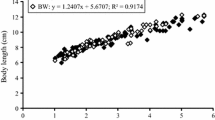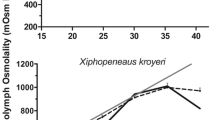Abstract
Four species of freshwater clam,Anodonta anatina, A. cygnea, Unio pictorum, andU. tumidus were exposed for 2 weeks to acidified soft water (pH 4.0–4.5, Ca 4.6 mg/L) and for 4 weeks to acid in hard water conditions (Ca 18.5 mg/L). The exposures caused a decrease in Na+, K+, and Cl− ion and a rapid increase of Ca2+ in the hemolymph. The elevation of the hemolymph Ca2+ was positively correlated with the decrease in the hemolymph pH in all species studied. Low ambient [Ca2+] level accelerated the pH decrease and Ca2+ increase in the hemolymph. Na+ and Cl− ion concentrations changed less rapidly in the soft conditions. Although there were minor changes in the mineral composition of the calcium concretions in the gills, the amount of calcium in the concretions did not change during the exposure. There was no correlation between the thickness of the shell and the ionic response, but all four species responded to low ambient pH in the same way.
Similar content being viewed by others
References
Agrell I (1949) The shell morphology of some Swedish unionids as affected by ecological conditions. Ark Zool 41:1–30
Bamber RN (1987) The effects of acidic sea water on young carpetshell clamsVenerupis decussata (L.) (Mollusca: Venaracea). J Exp Mar Biol Ecol 108:241–260
Chang PSS, Malley DF, Huebner JD (1988) Response of the musselAnodonta grandis to acid and aluminum. Comparison of blood ions from laboratory and field. Can Tech Rep Fish Aquat Sci 1607:157–161
Daye PG, Garside ET (1976) Histopatological changes in surfacial tissues of brook trout,Salvelinus fontinalis (Mitchell), exposed to acute and chronic levels of pH. Can J Zool 54:2140–2155
Doherty FG, Cherry DS, Cairns J Jr (1987) Valve closure responses of the Asiatic clamCorbicula fluminea exposed to cadmium and zinc. Hydrobiologia 153:159–167
Eddy FB, Bath RN (1979) Effects of sodium and chloride fluxes in the goldfishCarassarius auratus. J Comp Phys 129:145–149
France RL (1985) Low pH avoidance by crayfish (Orconectes virilis): Evidence for sensory conditioning. Can J Zool 63:258–262
Hemelraad J, Holwerda DA, Teerds KJ, Herwig HJ, Zandee DI (1986) Cadmium kinetics in freshwater clams. II. A comparative study of cadmium uptake and cellular distribution in the UnionidaeAnodonta cygnea, Anodonta anatina, andUnio pictorum. Arch Environ Contam Toxicol 15:9–21
Hõbe H, Wood CM, McMahon BR (1984) Mechanism of acid-base and ionoregulation in white suckers (Catostomus commersoni) in natural soft water. I. Acute exposure to low ambient pH. J Comp Physiol B 154:35–46
Holwerda DA, Veenhof PR (1984) Aspects of anaerobic metabolism inAnodonta cygnea L. Comp Biochem Physiol 78B:707–711
Istin M, Girard JP (1970) Dynamic state of calcium reserves in freshwater clam mantle. Calc Tiss Res 5:196–205
Kat PW (1972) Shell dissolution as a significant cause of mortality forCorbicula fluminea (Bivalvia:Corbiculidae) inhabiting acidic waters. Malacol Rev 15:129–134
Malley DF, Chang PSS (1985) Effects of aluminum and acid on calcium uptake by the crayfishOrconectes virilis. Arch Environ Contam Toxicol 14:739–747
Malley DF, Huebner JD, Donkersloot K (1988) Effects of ionic composition of blood and tissues ofAnodonta grandis grandis (Bivalvia) of an addition of aluminum and acid to a lake. Arch Environ Contam Toxicol 17:479–491
McDonald DG (1983a) The effects of H+ upon the gills of freshwater fish. Can J Zool 61:691–703
— (1983b) The interaction of calcium and low pH on the physiology of the rainbow trout,Salmo gaimeri. I. Branchial and renal net ion and H+ ion fluxes. J Exp Biol 102:141–155
McDonald DG, Walker RL, Wilkes PRH (1983) The interaction of environmental calcium and low pH on the physiology of the rainbow trout. II. Branchial ionoregulatory mechanism. J Exp Biol 102:141–155
Murphy WA, Dietz TH (1976) The effects of salt depletion on blood and tissue ion concentration in the freshwater mussel,Ligumia subrostrata (Say). J Comp Physiol 108:233–242
Økland J, Økland KA (1986) The effects of acid deposition on benthic animals in lakes and streams. Experientia 42:471–486
Pedder SCJ, Maly EJ (1987) The effect of avoidance on the plasmacation concentration of brook trout (Salvelinus fontinalis) subjected to varying levels of acidity. Aquat Toxicol 10:29–40
Potts WTW (1954) The inorganic composition of the blood ofMytilus edulis andAnodonta cygnea. J Exp Biol 31:376–385
Pynnönen K, Holwerda DA, Zandee DI (1987) Occurrence of calcium concretions in various tissues of freshwater mussels, and their capacity for cadmium sequestration. Aquat Toxicol 10:101–114
Servos MR, Brooke JB, Mackie GL (1985) Reproduction of selected mollusca in some low alkalinity lakes in south-central Ontario. Can J Zool 63:511–515
Servos MR, Malley DF, Mackie GL, LaZerte DB (1987) Lack of bioaccumulation of metals byElliptio complanata (Bivalvia) during acidic snowmelt in three south-central Ontario streams. Bull Environ Contam Toxicol 38:762–768
Silverman H, Steffens WL, Dietz TH (1983) Calcium concretions in the gills of a freshwater mussel serve as a calcium reservoir during periods of hypoxia. J Exp Zool 227:177–189
Silverman H, McNeil JW, Dietz TH (1987) Interaction of trace metals Zn, Cd, and Mn, with Ca concretions in the gills of freshwater unionid mussels. Can J Zool 65:828–832
Witters H (1986) Acute acid exposure of rainbow trout,Salmo gairdneri Richardson: effects of aluminum and calcium on ion balance and haematology. Aquat Toxicol 8:197–210
Wood CM, Rogano MS (1986) Physiological responses to acid stress in crayfish (Orconectes): haemolymph ions, acid-base status, and exchanges with the environment. Can J Fish Aquat Sci 43:1017–1026
Author information
Authors and Affiliations
Rights and permissions
About this article
Cite this article
Pynnönen, K. Physiological responses to severe acid stress in four species of freshwater clams (unionidae). Arch. Environ. Contam. Toxicol. 19, 471–478 (1990). https://doi.org/10.1007/BF01059064
Received:
Revised:
Issue Date:
DOI: https://doi.org/10.1007/BF01059064




